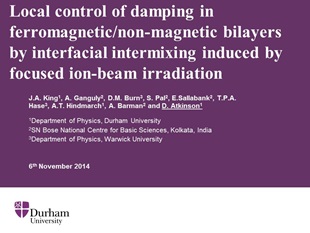
Local Control of Damping in Ferromagnetic/Non-magnetic Bilayers by Interfacial Intermixing Induced by Focused Ion-Beam Irradiation
J.A. King, A. Ganguly, D.M. Burn, S. Pal, E. Sallabank, T.P.A. Hase, A.T. Hindmarch, A. Barman and D. Atkinson
Magnetism and Magnetic Materials Honolulu, Hawaii Nov 2014
Magnetisation dynamics in the picosecond regime are largely determined by damped precessional behaviour. Damping has, therefore, received significant research effort, both in terms of the fundamental physics involved and for technological applications. In general, the control of magnetic properties at the micro- and nano-scale is important for technological applications. Focused ion beam irradiation provides the opportunity for such highly-localised control and modification of magnetic properties. Here the influence of interfacial intermixing on the picosecond precessional magnetisation dynamics of ferromagnetic/non-magnetic thin-film bilayers was studied [1]. Low-dose focused-ion-beam irradiation was shown to affect various aspects of the intrinsic magnetisation behaviour in such bilayers [2]. The influence on damping of ion-beam induced intermixing across the interface between a 10 nm Ni81Fe19 layer and a 2-3 nm capping layer of either Au or Cr was studied here. Time-resolved MOKE was used to study magnetisation dynamics and determine the damping as a function ion-beam dose. Detailed structural analysis of NiFe/Au bilayers was used to show the nature of the intermixing at the bilayer interface [3].
With a Au cap the damping behaviour of the un-irradiated bilayer was comparable with native Ni81Fe19 and increased with increasing ion dose. In contrast, for the as-deposited Ni81Fe19/Cr bilayer the damping was higher than for native Ni81Fe19, but decreased with increasing ion beam dose. Furthermore, field-dependent damping measurements of the NiFe/Au films showed the damping decreased steadily with increasing frequency, indicating an extrinsic two-magnon type contribution to the damping, that may be attributed to increasing disorder at the interface. This contrasts with the behavior observed for MBE grown Au on Fe, where the damping was enhanced by spin-pumping effects. For the NiFe/Cr the damping was invariant with increasing precessional frequency. This indicates an enhancement of the intrinsic damping with Cr cap, which contrasts with the effect of Cr on Fe observed for MBE grown samples reported elsewhere.
[1] J.A. King et al. Appl. Phys. Lett. 104, 242410 (2014)
[2] D.M. Burn, T.P.A. Hase and D. Atkinson J. Physics: Cond Mat; 26(23): 236002 (2014)
[3] E. Arac et al. J. Appl. Phys. 111, 044324 (2012)